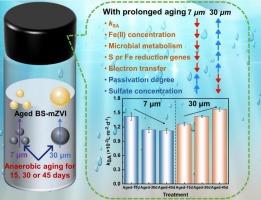New insights into the influence mechanisms of particle size on the aging behavior and TCE removal of biogenic sulfidated mZVI in groundwater
IF 9
1区 工程技术
Q1 ENGINEERING, CHEMICAL
引用次数: 0
Abstract
In-situ biogenic sulfidation of microscale zero-valent iron (mZVI) is an efficient and green method to enhance its dechlorination in groundwater. However, for practical field applications, the technology must maintain long-term effectiveness. At present, the performance evolution of aged biogenic sulfidated mZVI (BS-mZVI), especially regarding the influence of particle size, remains unclear and needs further investigation. In this study, BS-mZVI with two particle sizes (7 μm and 30 μm) was aged for 15, 30, and 45 days and systematically compared. The results showed that smaller particles (7 μm) achieved rapid initial trichloroethylene (TCE) removal (95 % in 6 days), but their reactivity declined with prolonged aging (kSA = 1.12 × 10−2 L·m−2·d−1 with 45-day aging). Conversely, larger particles (30 μm) exhibited improved reactivity over time, reaching a kSA of 1.57 × 10−2 L·m−2·d−1 after 45-day aging while maintaining over 92 % TCE removal. Surface characterization revealed that aged BS-mZVI (7 μm) developed increased hydro(oxide) passivation layers (Fe2O3/FeOOH) from 15 to 45 days of aging, which decreased its reactivity. In contrast, aged BS-mZVI (30 μm) gradually formed conductive FeSx shells during aging, retaining hydrophobicity and enhancing reactivity. Metagenomic analysis further revealed that with prolonged aging (15 to 45 days), the 30 μm BS-mZVI enriched sulfate-reducing bacteria (SRB) and iron-reducing bacteria (IRB), accompanied by higher abundances of key functional genes involved in sulfate and iron reduction, thereby promoting sustained TCE degradation. These particle size-dependent results demonstrate that smaller BS-mZVI enables rapid TCE decontamination, whereas larger particles offer prolonged reactivity, helping to choose materials based on the needed remediation timeframe required in applications.

粒径对地下水中生物硫化mZVI老化行为及TCE去除影响机制的新认识
微型零价铁(mZVI)原位生物硫化是一种高效、绿色的地下水脱氯方法。然而,对于实际的现场应用,该技术必须保持长期的有效性。目前,老化生物源硫化mZVI (BS-mZVI)的性能演变,特别是粒径的影响尚不清楚,需要进一步研究。本研究采用7 μm和30 μm两种粒径的BS-mZVI进行了15、30和45 天的老化试验,并进行了系统比较。结果表明,粒径较小的颗粒(7 μm)在6 d内可快速去除三氯乙烯(TCE)(95% %),但随着时效时间的延长,其反应性下降(kSA = 1.12 × 10−2 L·m−2·d−1,时效时间为45 d)。相反,随着时间的推移,较大的颗粒(30 μm)表现出更好的反应性,经过45天的老化,kSA达到1.57 × 10−2 L·m−2·d−1,同时保持超过92 %的TCE去除率。表面表征表明,时效后的BS-mZVI(7 μm)在时效15 ~ 45 d期间,氢(氧化物)钝化层(Fe2O3/FeOOH)增加,反应性降低。而老化的BS-mZVI(30 μm)在老化过程中逐渐形成导电的FeSx壳,保持疏水性,增强反应性。宏基因组分析进一步发现,随着老化时间的延长(15 ~ 45 d), 30 μm BS-mZVI富集硫酸盐还原菌(SRB)和铁还原菌(IRB),并伴有硫酸盐和铁还原关键功能基因的丰度增加,从而促进了TCE的持续降解。这些颗粒大小相关的结果表明,较小的BS-mZVI可以快速去除TCE污染,而较大的颗粒可以延长反应性,有助于根据应用中所需的修复时间框架选择材料。
本文章由计算机程序翻译,如有差异,请以英文原文为准。
求助全文
约1分钟内获得全文
求助全文
来源期刊

Separation and Purification Technology
工程技术-工程:化工
CiteScore
14.00
自引率
12.80%
发文量
2347
审稿时长
43 days
期刊介绍:
Separation and Purification Technology is a premier journal committed to sharing innovative methods for separation and purification in chemical and environmental engineering, encompassing both homogeneous solutions and heterogeneous mixtures. Our scope includes the separation and/or purification of liquids, vapors, and gases, as well as carbon capture and separation techniques. However, it's important to note that methods solely intended for analytical purposes are not within the scope of the journal. Additionally, disciplines such as soil science, polymer science, and metallurgy fall outside the purview of Separation and Purification Technology. Join us in advancing the field of separation and purification methods for sustainable solutions in chemical and environmental engineering.
 求助内容:
求助内容: 应助结果提醒方式:
应助结果提醒方式:


